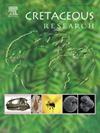Palaeoceanographic changes during the late Albian-early Turonian in the Sergipe-Alagoas Basin (Northeast Brazil) and their link with global events
IF 1.9
3区 地球科学
Q1 GEOLOGY
引用次数: 0
Abstract
The mid-Cretaceous was characterized by extreme greenhouse conditions, long-term sea level rise, and tectonic processes that influenced the dynamics of oceanic systems. The global carbon cycle was affected by major perturbations during Oceanic Anoxic Events (OAEs). We present new integrated geochemical, magnetic, and mineralogical data from a core drilled through late Albian to early Turonian sediments in the Sergipe-Alagoas Basin, off northeastern Brazil, which includes one of the few records of the OAE2 from the South Atlantic Ocean. The obtained results show a major change in sedimentation in the middle Cenomanian when mixed carbonate and siliciclastic deposits were replaced by chalk. This transition reflects a major change in palaeoceanographic conditions toward a more stable circulation mode, with better connection between the different oceanic basins, persistent currents, and bottom ventilation. Cyclicity in the ln(K/Al) record indicates insolation-driven fluctuations in aridity and humidity. A new age model, based on the stable 405 kyr-long eccentricity cycles, places the onset of the OAE2 carbon isotope excursion at ∼94.74 Ma. Sedimentation during the OAE2 seemed to be mainly controlled by long-term processes and local effects rather than global perturbations. Variations in ln(Sr/Ca) indicate increased primary productivity persisting for two long eccentricity cycles, while transient reducing conditions, inferred from loss in magnetic susceptibility compared to Fe, persisted across the earliest long eccentricity maximum phase, at least.
巴西东北部Sergipe-Alagoas盆地albian晚期- Turonian早期古海洋学变化及其与全球事件的联系
白垩纪中期以极端温室条件、长期海平面上升和影响海洋系统动力学的构造过程为特征。在海洋缺氧事件(oae)期间,全球碳循环受到重大扰动的影响。在巴西东北部的Sergipe-Alagoas盆地,我们提供了新的综合地球化学、磁场和矿物学数据,这些数据来自于钻取的一个岩心,该岩心穿过了晚Albian至早Turonian的沉积物,其中包括来自南大西洋的少数OAE2记录之一。结果表明,中塞诺曼期碳酸盐和硅质混合沉积被白垩取代,沉积发生了重大变化。这种转变反映了古海洋学条件向更稳定的环流模式转变,不同海洋盆地、持续流和海底通风之间的联系更好。ln(K/Al)记录的循环性表明由日照驱动的干湿波动。基于稳定的405 kyr-长偏心率周期,一个新的年龄模型认为OAE2碳同位素偏移开始于~ 94.74 Ma。OAE2期间的沉积似乎主要受长期过程和局部效应控制,而不是全球扰动。ln(Sr/Ca)的变化表明初级生产力的增加持续了两个长偏心周期,而与Fe相比,从磁化率损失推断的瞬态降低条件至少持续了最早的长偏心最大阶段。
本文章由计算机程序翻译,如有差异,请以英文原文为准。
求助全文
约1分钟内获得全文
求助全文
来源期刊

Cretaceous Research
地学-地质学
CiteScore
4.10
自引率
19.00%
发文量
235
审稿时长
12 weeks
期刊介绍:
Cretaceous Research provides a forum for the rapid publication of research on all aspects of the Cretaceous Period, including its boundaries with the Jurassic and Palaeogene. Authoritative papers reporting detailed investigations of Cretaceous stratigraphy and palaeontology, studies of regional geology, and reviews of recently published books are complemented by short communications of significant new findings.
Papers submitted to Cretaceous Research should place the research in a broad context, with emphasis placed towards our better understanding of the Cretaceous, that are therefore of interest to the diverse, international readership of the journal. Full length papers that focus solely on a local theme or area will not be accepted for publication; authors of short communications are encouraged to discuss how their findings are of relevance to the Cretaceous on a broad scale.
Research Areas include:
• Regional geology
• Stratigraphy and palaeontology
• Palaeobiology
• Palaeobiogeography
• Palaeoceanography
• Palaeoclimatology
• Evolutionary Palaeoecology
• Geochronology
• Global events.
 求助内容:
求助内容: 应助结果提醒方式:
应助结果提醒方式:


